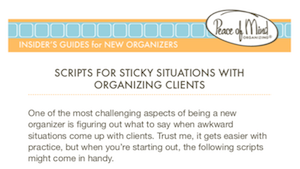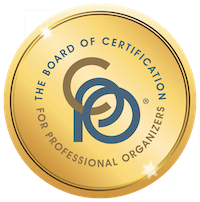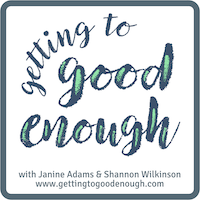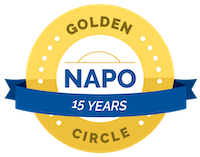Worth repeating (once again): Why I'm a professional organizer
I originally wrote this post on why I became a professional organizer in 2013. Five years later, it still rings true. I will add that one other thing that keeps me going as a PO is the opportunity to help my fellow organizers hone their skills and earn income by working on my teams. I feel so fortunate to still enjoy my work after 13 years in business. If you’ve ever wondered what a PO gets out of her work—which to some people looks decidedly unglamorous—read on.
Often when I meet folks who learn what I do for a living, they’re keen on learning how I became a professional organizer. I explain the training I took and how I went about starting my business. (That’s all detailed in my blog post, Are you interested in becoming a professional organizer?)
But seldom am I asked why I became a PO, rather than how. I thought I’d spend a little time today exploring that question.
In my observation, there are two sorts of folks who become professional organizers:
- Those who do it because organizing comes so naturally to them. Being organized is like breathing. It’s their passion. So why not make a living doing it?
- Those who enter the field because of their own struggles in getting and staying organized. They’ve spent a lifetime seeking solutions for themselves and want to share those solutions with others.
I fall into that second camp. As I’ve mentioned over and over, I’m a naturally messy person. I’m pretty organized in my space and I’m definitely organized inside my head, but I’m a bit messy and unruly. I sought solutions for my time management and clutter issues throughout my life and I learned a lot. I felt it was time to start sharing.
When I first contemplated starting my business, I was a freelance writer. I’d been writing about pets for ten years and had written hundreds of articles on various aspects of pet care. I’d had seven books published (most of which are no longer available) and contributed to several others. I was working on my last book, an ill-fated venture called Jane Goodall’s Return to Gombe co-written with the famed primatologist. The process of that book about killed me (and was never published) and I knew that in order to get through writing that manuscript I had to know it was going to be my last book. So I started looking for other things to do.
As I considered becoming a PO, I thought of several very important things that being a professional organizer would offer that being a freelance writer was not delivering:
- The ability to help people directly and tangibly
- Respect for my expertise (I was being very disrespected during the whole Goodall book experience)
- Payment at the time of service
That was very appealing and a big part of why I became a PO. But why do I keep doing it, now that I’m in my eighth fourteenth year of business?
Those initial three reasons did prove to be powerful rewarding. In addition, here are some other things I’ve found to be very rewarding:
- I get to help people transform their lives.
- I help people feel better about themselves as I normalize (and empathize with) their messy behaviors.
- I can help my clients go from striving (and failing) to be perfectly organized to reveling in being organized enough.
- I get to effect vast, fast change for my St. Louis clients by bringing in a team of organizers.
Being a professional organizer is life-changing work for me. And its results can be life changing for my clients. It is easily the most rewarding work I’ve done in a career that’s spanned more than three decades. And as long as it continues to be this rewarding, I’ll keep doing it.
NAPO's Stand Out podcast

I love podcasts. They keep me company when I’m driving and when I’m doing laundry and other tasks. If you like podcasts too, I hope you’ve checked out my podcast (with life coach Shannon Wilkinson), Getting to Good Enough.
If you’re reading this blog, you may very well be a professional organizer or perhaps an aspiring organizer. That’s why I want you to know about Stand Out the podcast from the National Association of Productivity and Organizing Professionals (NAPO). Stand Out is produced for professional organizers, but its content would be useful to all sorts of small business owners.
Host (and professional organizer) Sarah Karakaian does a great job interviewing guests for each episode. (There are new episodes twice a month.) I just listened to Episode 15: Living Fearlessly with Rachel Henken, transformative coach and author of Living Fearlessly. I find myself going back to it in my mind. In it, she talks about being effortlessly productive and how being overly focused on what you need to do stresses you out and causes you to get less done. That is a notion worth pondering.
I’m also a big fan of Episode 1, in which my friend Geralin Thomas, an organizer and coach to organizers, was interviewed. It’s entertaining and full of wisdom.
I encourage you to check out Stand Out, especially if you’re a professional organizer or aspiring organizer. If you’re a lover of podcasts, I think you might find it interesting.
Introducing Amy Hubbard, my first employee

Amy with Bix, my poodle
For ten years now, I’ve been leading organizing teams to create swift and dramatic change. Until this month, my teams have always been made up of independent contractors, fantastic organizers who have their own businesses (and insurance). They are all members of the St. Louis chapter of the National Association of Productivity and Organizing Professionals (NAPO-St. Louis).
This month, I took what feels like a big step and hired my first employee, Amy Hubbard. Amy will be working with me as an organizer. She’ll be a team member, a team leader, and also work one-on-one with clients. She’ll be working part-time for me, because she also works as a freelance makeup artist. Amy is a natural-born organizer with a beautiful aesthetic and has a lovely, calm demeanor. She’s terrific.
The process of hiring my first employee was a bit stressful. There were a lot of bureaucratic hoops to jump through. I needed to come up with a different pay scale (the pricing for clients remains unchanged). And I had to write up policies and operations because I’m not permitted, by law, to tell independent contractors how to do their work. There were lots of things to think about.
So why did I go through the trouble? Primarily because I wanted Amy on my team. She is an experienced and talented organizer. (She’s worked for other organizing companies in St. Louis and elsewhere.) And she is not interested in owning her own business, so I couldn’t hire her as a contractor. I’d been toying with the idea of hiring employees for years now. Amy gave me a big reason to take the plunge.
Since she’s an employee, I’m able to train Amy about how I like organizing done. It feels like the first step in a process of building a more cohesive company. And now that I’ve gone through the red tape of hiring one employee, it will be easier for me to hire more employees. I may hire organizers or hire employees in other roles.
This feels like a big shift to me, but the change should not have a big impact on my clients’ experience. I’ll continue to use wonderful independent contractors on my teams. We’ll still do excellent work. But Amy will, I hope, be a consistent member of my teams.
If you’re a current client (or a future one!), I look forward to your meeting Amy. This feels like a big milestone for Peace of Mind Organizing® and I’m looking forward to seeing where it leads!
Worth repeating: Working with a professional organizer
Back in 2011, I wrote a blog post aimed at helping those of you who might be interested in working with a professional organizer make the most out of the experience. I asked other professional organizers to comment, which made the post even more valuable. I re-read it the other day and thought it would be worth running again. To get the maximum benefit, go back to the original post and read those comments.
If you’re reading an organizing blog, chances are pretty good that you fall into one of three camps:
- You’re a professional organizer (or an aspiring one)
- You’d like to work with a professional organizer
- You’re a fairly organized DIYer looking for ideas
This post is for those of you who fall into the second category. If you’d like to work with a professional organizer, I’d love to provide you with some advice to optimize that experience, should it come to pass.
Choosing an organizer
- Check out your choices thoroughly. You can find professional organizers at the website of National Association of Productivity and Organizing Professionals and the Institute for Challenging Disorganization. If you’re in St. Louis, you can go to the NAPO-St. Louis website to see all the chapter members. (If you’re not in St. Louis, you can check here to see a list of NAPO chapters and their websites.) Choose some local organizers and read websites, look at testimonials and before and after pictures. Call any organizers you’re interested in who don’t have websites.
- Ask around. If you know folks who have worked with organizers, quiz them on their experience
- Know what you’re looking for. Do you want an organizer who tells you what to do (some people do)? Or one who involves you in the process of coming up with solutions?
- Trust your gut. If an organizer’s website or telephone manner resonates with you, that’s a good reason to pick her (or him).
- Don’t bargain shop. This is a field where fees are usually commensurate with training and experience. If you’re challenged by chronic disorganization, for example, you’d be wise to select an organizer with training and experience in working with chronically disorganized clients. And you may well pay more for that.
Working with an organizer
- Resist the temptation to clean up for your organizer. If your home is messy, you may feel embarrassed. Try to set that aside so that the organizer can see the natural state of your home in order to help you best. Mess and piles can provide clues.
- Be honest. Try not to anticipate what the organizer wants to hear. Instead, just answer all questions honestly, even if you’re a little embarrassed. Your organizer can help you best if you’re honest in everything you tell her.
- Be realistic. How long have you been dealing with disorder in your life? Probably quite some time. Unfortunately, organizers don’t have magic wands, so we can’t fix things instantly. Recognize that this is a process that might take awhile.
- Be prepared to learn new behaviors. If you’re dealing with a lot of clutter, the first step might be decluttering. But after that, you’re more than likely going to need to change your habits and create new routines to ensure that the clutter doesn’t come back. If you don’t change your behavior, the order that you and your organizer create might be temporary.
- Do your homework. If you and your organizer agree that you’ll do homework, try to accomplish it. If you don’t it’s usually not a big deal. But being honest and realistic about the prospect of what you can accomplish between appointments can help your organizer better plan the next session.
- Trust your gut (again). If you’re not clicking with your organizer, don’t be afraid to talk with her about it. This is intimate work and it’s essential that you have a trusting relationship and work well together. If you don’t feel it’s working with the organizer, perhaps the two of you can come up with a solution. If no solution is in sight, perhaps you can ask her for a referral.
- Keep your appointments. If you book an appointment with an organizer, try to keep that commitment. She’s set aside time for you and scheduled around that appointment. Last-minute cancellations can be costly for the organizer. And they’re costly for you, too, since you can’t get help if you don’t keep appointments.
- Expect backsliding. Most clients experience some backsliding, when life gets in the way and newly learned behaviors fall by the wayside. If you backslide, it doesn’t mean you’ve failed or your organizer isn’t effective. It just means you need to renew your efforts. Or perhaps tweak our systems.
- Be brave. It can be scary to let someone into your house for the first time in ages. It can also be scary to admit to your organizer that you haven’t done your homework or that you’ve not been able to maintain the order you created together. But organizers, by and large, are compassionate and non-judgmental people. Getting past the fear can help put you on the path to an orderly life.
When you hire a professional organizer, you’re making a time and financial commitment to getting organized. Often, you’re making an emotional commitment as well. That can be very powerful!
Do you have anything to add? I’d love to hear from POs or people who have worked with POs who would like to add to this list.
Modeling imperfection

Tomorrow evening, I’m having a dozen or so fellow professional organizers to my home. Our chapter of the National Association of Productivity and Organizing Professionals (NAPO-St. Louis) has social events every other month and they’re typically hosted by members in their homes. I volunteered for to host this month’s social. This is third one I’ve hosted since 2009.
Back in 2009, I had a semi-major freak out prior to the social. I was worried because my home was nowhere near model-home perfect. As I’ve explained here countless times, I’m a naturally messy person and my house is not perfectly kept.
At the time, my wise friend Margaret Lukens encouraged me to let go of that anxiety and “model imperfection” for the other organizers. The notion made me breathe a big sigh of relief and it took away a lot of the tension I’d built up around the event. I turned the whole thing into a post for the amazing blog Unclutterer. (Here’s that post, which they called Uncluttering is not a competition.)
I re-read the Unclutterer post this morning as I created my list of tasks to do to get the house ready for tomorrow night. (I have a client tomorrow, so everything has to be done today.) Two things came to mind as I read it: (1) After an additional nine years as a professional organizer, my house is a lot more presentable than it was then—we’ve even renovated the kitchen. (2) No one’s judging me. Organizers are non-judgmental people; otherwise we could never succeed in our businesses.
There are a few things I’m going to do that will allow me to let this be easy:
- I’m going to serve exactly what I served last time. When I hosted the organizers in 2015, a friend and colleague told me what to serve. Happily, I took note of what I bought at Trader Joe’s and the supermarket and I’m going to buy exactly the same thing. Why reinvent the wheel?
- I’m accepting help. My friend and team member Terry Capehart of Organization in Bloom offered to come early and help. I said yes.
- I’m letting go of worries that people will care about the many imperfections in my home. Chances are they won’t even notice, especially with my standard poodle, Bix, doing his best to distract them.
In Episode 8: You Be You of our podcast, Getting to Good Enough my co-host Shannon Wilkinson and I talk about how it’s our own standards that count (not those of other people) and how comparing yourself to others isn’t helpful. As I prepare my house for tomorrow’s guests, I’m going to keep that in mind.
Photo by Amy Shamblen on Unsplash.
Why I love American Ninja Warrior
My favorite summer TV series is NBC’s American Ninja Warrior. It’s the only show I watch live, because I can’t stand to wait until the next day to watch online. I watch it with my 87-year-old father when I’m visiting him and when I’m not there, we talk about it the next day over the phone.
In case you’re not familiar with it, American Ninja Warrior is a competition show, in which men and women race against the clock on ridiculously difficult obstacle courses. There are qualifying contests in a variety of cities. The top competitors in each city qualifier advance to the city final. The top competitors of the city final advance to the national competition in Las Vegas, which has up to four stages. The competitor who makes it fastest through the fourth stage wins a million dollars. So far, in nine seasons (the current season is the tenth), only two competitors made it to Stage Four (they were both in the same year), so only one has one the grand prize. This is crazy difficult.
People are sometimes surprised when I talk enthusiastically about the show. After all, it’s not exactly the epitome of sophistication. It’s noisy and has lots of flashing lights and yelling people and loud commentators. But it is so enjoyable and inspirational.
Here are some of the reasons I love it:
- Men and women compete on an equal playing field. That’s right, all competitors run the exact same course. The only advantage women are given is that the top five will advance to the city finals, even if they’re not in the top 30, and the top two will advance from the city finals to Las Vegas, even if they’re not in the top 15. That’s it. These women are unbelievable. Watch Allyssa Beird (a fifth-grade teacher!) finish Stage One in national final in Las Vegas last year:
- Old and young compete on the same course. This year they dropped the minimum age to 19 (from 21). There is no maximum age. One of my favorite competitors is Jon Stewart, who is my age. This year, at the age of 56, he finished the Dallas qualifiers, breaking his own record as the oldest person to finish a city qualifier. How can you not shout, “Go, Jon!” while you’re watching?
And here’s the youngest woman ever to hit to hit a buzzer, 20-year-old Casey Rothschild, a college student, at the Philadelphia qualifier, also this year.
- The competitors all support one another. It’s really wonderful to watch the competitors don each others’ fan t-shirts and cheer each other on. Great sportsmanship is always on display. In the video above, you can see Allyssa’s fellow women Ninjas going crazy for her. One of her closest competitors, who had failed that course, is shown crying with joy.
- They have such good attitudes when they fail. They almost always smile after falling and usually the comment is, “That was so much fun!” Even when the Ninja superstars (who are always expected to finish) fail, they just shrug and say some form of, “It happens to the best of us.” Witness superstar Drew Dreschel’s reaction after his embarrassing fall on the second obstacle in the 2014 Miami final.
- They showcase amazing come-back stories. Recently, there was an amputee who competed with prosthetic legs. There was a previous competitor who, between seasons, had been electrocuted and nearly died. There are always cancer survivors and people who have overcome all sorts of adversity. Again, inspirational.
Watching American Ninja Warrior is a wholesome, positive experience. It’s enthralling, inspirational, and a highlight of my summer each year. While ANW is a summer phenomenon, there are specials and variations you can see at other time of the year, I also love American Ninja Warrior: Ninja vs Ninja on the USA Network, which has teams of three ninjas, competing head to head, tournament style. Those courses are shorter because they’re all about speed. There is always at least one woman on a three-person team. So fun. There are also all-star competitions, international team competition, and even a celebrity edition (for Red Nose Day).
You can watch American Ninja Warrior on the NBC website and on Hulu. You can see clips on You Tube. You can purchase whole seasons (like I’ve done) on Amazon video. You can watch Ninja vs Ninja on the USA Network’s website. And you can tune in live tonight at 9/8 central!
Scripts for sticky situations (New Insider's Guide)

I’m really excited to announce a fifth title to my series of Insider’s Guides for New Organizers. This one, called Scripts for Sticky Situations with Organizing Clients provides suggested scripts for 20 different situations you might encounter with organizing clients.
Each scenario has at least two suggested scripts, which are designed to prepare new organizers so that these situations will be less awkward. In 13 years of business, I’ve navigated all these situations without a map. I’m hoping this guide will help you handle these situations without stress if you encounter them.
Topics include:
- Clients home is too cluttered or squalid
- Client could benefit from a therapist
- Client isn’t letting go of enough
- You’re not making fast progress
- You’re raising your rates
- Client is dissatisfied
- Client is not a good match
- Client’s check bounces
- Prospective client balks at your rates
Plus 11 more!
Insider’s Guides for New Organizers are concise, downloadable pdfs that sell for $9 each. This new guide is 17 pages.
Click here to purchase!
Links
- Peace of Mind Budgeting
- Institute for Challenging Disorganization
- Are you interested in becoming a professional organizer?
- NAPO St. Louis
- National Association of Productivity and Organizing Professionals
- Shannon Wilkinson, life coach
- Getting to Good Enough podcast
- Organize Your Family History
- Ravelry






